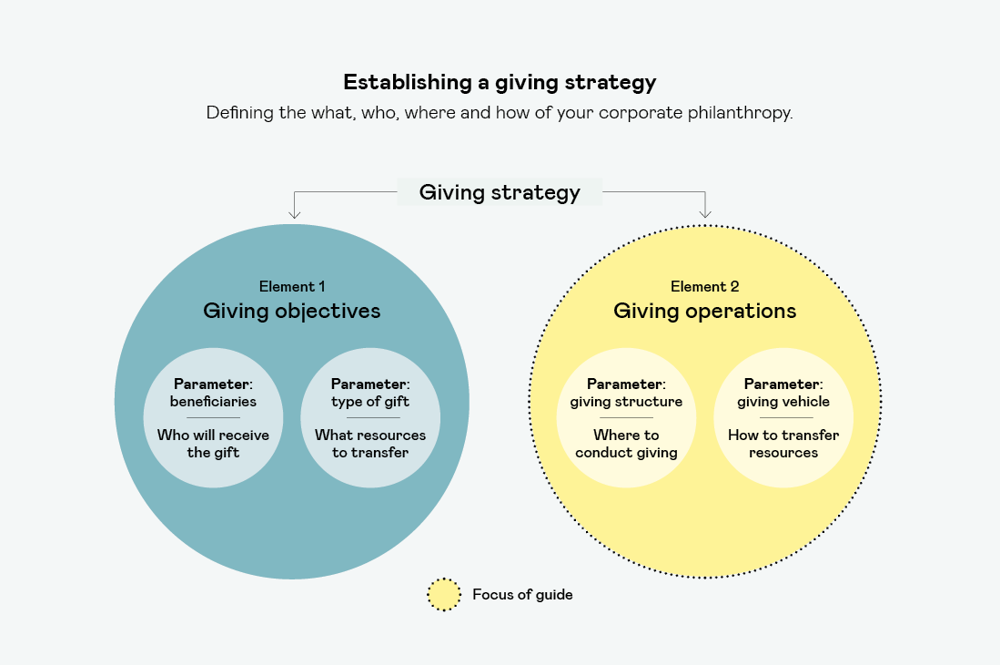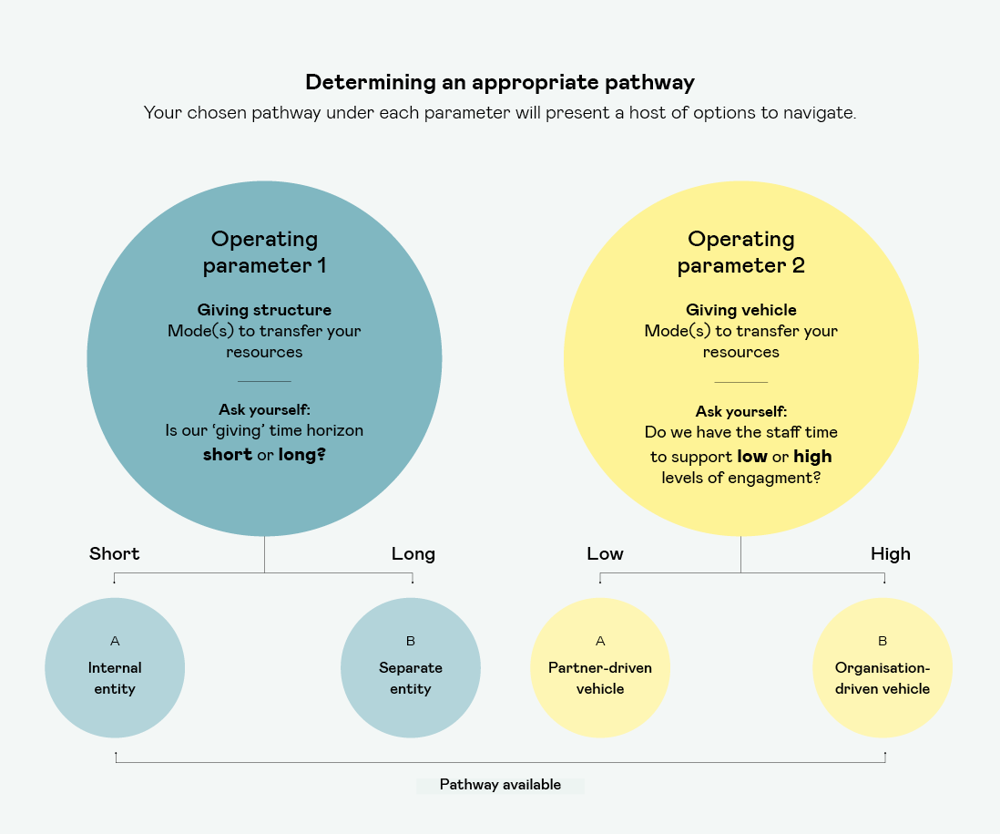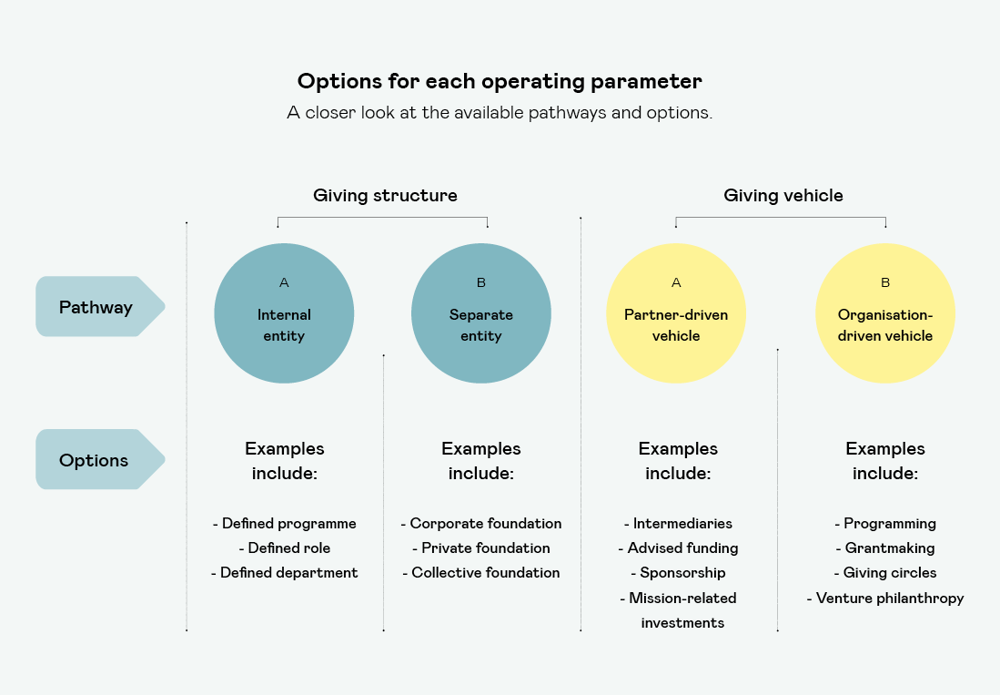Strategy for corporate giving
This guide introduces operating structures and vehicles common to corporate philanthropy along with practical advice for navigating available options

This guide introduces operating structures and vehicles common to corporate philanthropy along with practical advice for navigating available options

This guide introduces operating structures and vehicles common to corporate philanthropy. It also offers practical advice for navigating the available options.
A simplified giving strategy typically has two key elements and defines the what, who, where, and how of your initiative. The first element, your giving objectives, is defined by what you plan to give and to whom.
The second element, your operations, is defined by where your giving is conducted and what mode you use to make those gifts. This guide will focus on the operations element of the giving strategy.
Defining a giving strategy becomes indispensable when your philanthropy becomes more formalised. Whatever the motivation for upgrading your corporate giving – be it community support, leadership directive, customer loyalty, employee engagement or otherwise – the decision to move beyond simple cheque-writing ushers in a host of choices as you set the details of your strategy.

Along with defining your objectives, a critical early step in setting your giving strategy is to determine your two operating parameters.
To set each parameter, you must take an honest account of your ambitions and resources to make an informed choice between the pathways available to you and the host of options associated with them. Once these parameters are set, they will form the operating pillars of your strategy from which many other details will flow.

Adopting a giving structure and giving vehicle is a major decision with far- reaching implications.To support an efficient approach to decision-making when there are multiple pathways and options available, it can be helpful to have a firm understanding of time. This incorporates both:
Once these are clear, you can then narrow your focus to the pathway that is best suited for your individual circumstances.

Determining ‘where’ to conduct your corporate giving is not about geography. It refers to whether giving operations are hosted from within your existing organisational structure or separately. Understanding your time horizon is integral to selecting an optimal giving structure pathway because setting up a separate entity can be an intensive process on multiple fronts.
If your timeframe is short or ambiguous, it is prudent to manage your giving internally. If your horizon is long, you can still opt to conduct giving in-house, but you may also be willing to invest in establishing a new legal entity, with the various benefits that offers.
Embedding your giving within your existing organisation is a natural starting place for many initiatives. Compared to separate entities, they can be efficient to mobilise and can be routinely funded through your existing annual budgeting process. They do, however, typically generate less public awareness – something to consider if that is a primary goal of your philanthropy.
Options for conducting your giving as an internal entity include:
With a longer time horizon it may make sense to set up your giving operations as a separate entity. Standalone structures can win strong brand awareness but are more strenuous to establish than in-house operations. Implementing funding mechanisms can be particularly challenging as these entities are commonly supported by an endowment or a profit-sharing programme that can be difficult to define or build consensus around and are subject to changing regulations.
Options for conducting your philanthropy separately include:
Selecting your giving vehicle is the philanthropic equivalent to entering a ‘make/buy’ analysis or outsourcing decision in business. Understanding the staff-time you can devote to philanthropy is integral to selecting your giving vehicle pathway because managing corporate gifts can be a significant draw on employee resources.
If your available staff time for engagement is low relative to the size of your giving budget, you should consider partner-driven vehicles that rely heavily on external organisations. If you have the resources for high levels of engagement relative to your budget, you are well placed to drive the process internally if you choose to do so.
Inviting partners to support your giving is common and is how many organisations gain their footing in corporate philanthropy. In this low-engagement pathway, success relies on effective communication and healthy relationships with your partners.
Options for partner-led giving vehicles include:
With more staff time for engagement, it may be possible to adopt giving vehicles that allow your organisation to drive the philanthropic process. While labour intensive, organisation-driven vehicles offer more control over the giving process and greater contact with beneficiaries as compared to partner-driven models. In this high engagement pathway, organisation-wide commitment and clarity around future cash flow is critical to success.
Options for high-engagement giving vehicles include:
It's a good idea to use a strong password that you're not using elsewhere.
Remember password? Login here
Our content is free but you need to subscribe to unlock full access to our site.
Already subscribed? Login here